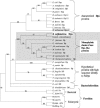An archaeal antioxidant: characterization of a Dps-like protein from Sulfolobus solfataricus
- PMID: 16024730
- PMCID: PMC1175829
- DOI: 10.1073/pnas.0501497102
An archaeal antioxidant: characterization of a Dps-like protein from Sulfolobus solfataricus
Abstract
Evolution of an oxygenic atmosphere required primordial life to accommodate the toxicity associated with reactive oxygen species. We have characterized an archaeal antioxidant from the hyperthermophilic acidophile Sulfolobus solfataricus. The amino acid sequence of this approximately 22-kDa protein shares little sequence similarity with proteins with known function. However, the protein shares high sequence similarity with hypothetical proteins in other archaeal and bacterial genomes. Nine of these hypothetical proteins form a monophyletic cluster within the broad superfamily of ferritin-like diiron-carboxylate proteins. Higher order structural predictions and image reconstructions indicate that the S. solfataricus protein is structurally related to a class of DNA-binding protein from starved cells (Dps). The recombinant protein self assembles into a hollow dodecameric protein cage having tetrahedral symmetry (SsDps). The outer shell diameter is approximately 10 nm, and the interior diameter is approximately 5 nm. Dps proteins have been shown to protect nucleic acids by physically shielding DNA against oxidative damage and by consuming constituents involved in Fenton chemistry. In vitro, the assembled archaeal protein efficiently uses H2O2 to oxidize Fe(II) to Fe(III) and stores the oxide as a mineral core on the interior surface of the protein cage. The ssdps gene is up-regulated in S. solfataricus cultures grown in iron-depleted media and upon H2O2 stress, but is not induced by other stresses. SsDps-mediated reduction of hydrogen peroxide and possible DNA-binding capabilities of this archaeal Dps protein are mechanisms by which S. solfataricus mitigates oxidative damage.
Figures







References
Publication types
MeSH terms
Substances
Grants and funding
LinkOut - more resources
Full Text Sources
Other Literature Sources
Medical

